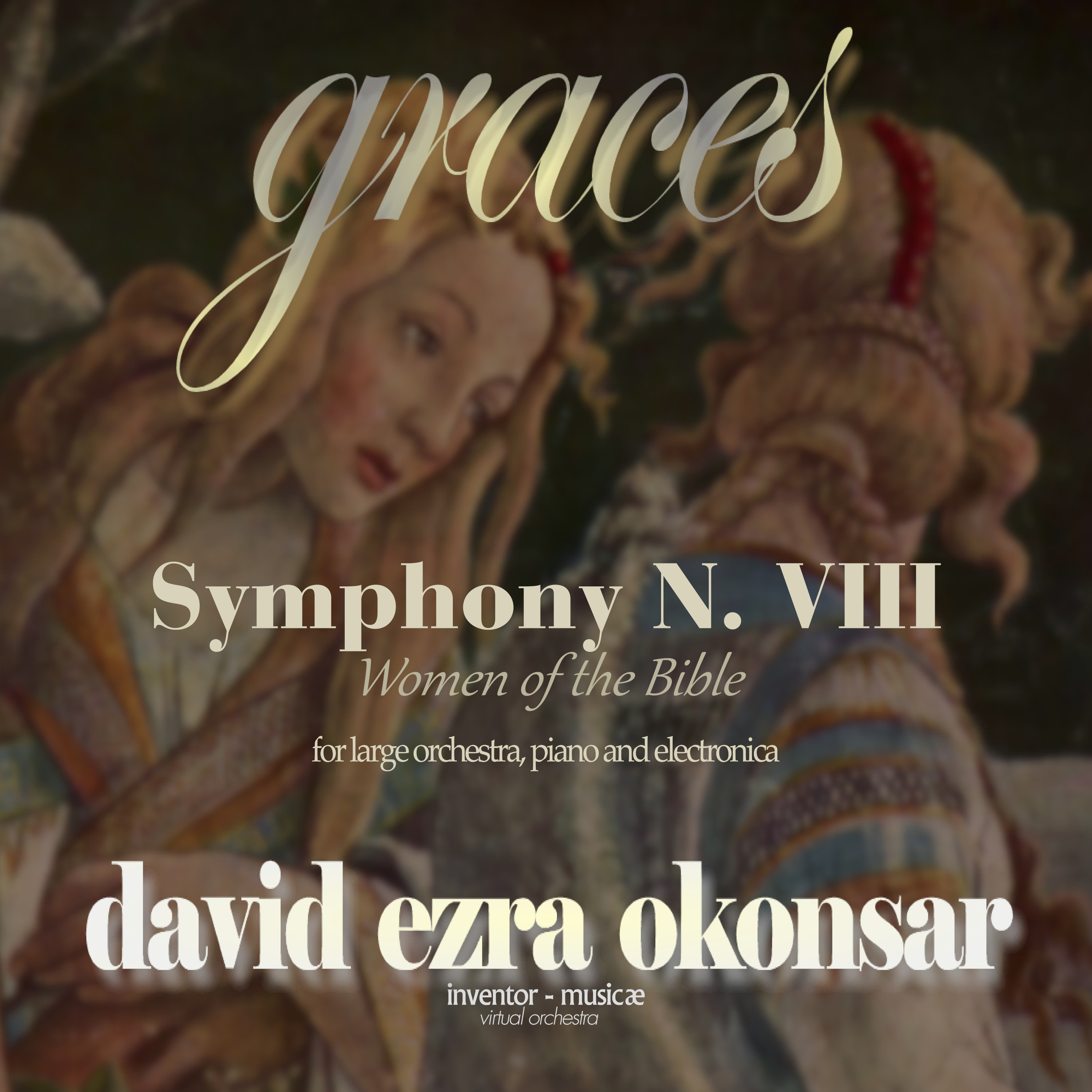
Downloads only. Physical CD not available.
|
The Symphony No. 8, "Graces," by David Ezra Okonsar, features the Women of the Bible. The Symphony is a celebration of femininity and strength. The women of the Bible are depicted with powerful and moving music that captures their stories and impact. Those stories are brought to life through intricate melodies and harmonies that showcase their resilience and unwavering faith. Feminity in the Bible is celebrated and revered as a source of inspiration and empowerment for all. It is a reminder of the strength and grace found in women throughout history. The Symphony begins with "Hannah," the first heroine of the cycle. Hannah is known for her unwavering faith and miraculous motherhood, symbolizing her intimate connection with God and deeply emotional journey. The powerful orchestration captures the essence of Hannah's story, inspiring listeners to find hope and resilience in their own lives. The second movement is "Mary," inspired by Mary's prayer in the Bible. Mary addresses G.d. with grace and humility, expressing her thanks for the blessings she has received. The music evolves introspectively and contemplatively, reflecting Mary's deep faith and devotion. "Miriam" is a musical piece that captures the spirit of perseverance and triumph. The song of Moses and Miriam celebrates their victory over the Egyptians at the Red Sea, inspiring others never to give up, no matter the odds. In Exodus 15:21, it is said that Miriam took a timbrel in her hand, and all the women followed her with timbrels. The third movement of the Symphony is a triumphant and joyful expression of their success and gratitude. The fourth movement is "Deborah". Deborah in the Bible is known for her leadership and wisdom. She is a powerful example of strength and courage. Her narrated story features themes of bravery and determination, showing listeners that they, too, can overcome obstacles and achieve greatness. "Lea and Rachel" is the fifth movement, and it is not directly based on the écritures. It is a story created with generated lyrics based on the complex relationship between those two Biblical women. The story of Lea and Rachel powerfully represents sacrifice and sisterhood in the face of adversity and portrays their unwavering loyalty and love for each other despite the challenges they face. The last movement, "Esther," features a strong and independent woman who risked her life to save her people. Esther was brave and determined, ultimately leading to the triumph of good over evil. As often with the music by Okonsar, the Symphony mixes several different styles and creates a unique and powerful listening experience that resonates with listeners on a deep emotional level. The complex harmonization and unusual instrumentation created by Okonsar make his music stand out in the classical music world. The result is a truly captivating and unforgettable musical journey. -------------------------------------------------- FR La Symphonie n° 8, « Grâces », de David Ezra Okonsar, met en vedette les femmes de la Bible. La Symphonie est une célébration de la féminité et de la force. Les femmes de la Bible sont représentées par une musique puissante et émouvante qui capture leurs histoires et leur impact. Ces histoires prennent vie grâce à des mélodies et des harmonies complexes qui mettent en valeur leur résilience et leur foi inébranlable. La féminité dans la Bible est célébrée et vénérée comme une source d'inspiration et d'autonomisation pour tous. C'est un rappel de la force et de la grâce trouvées chez les femmes à travers l'histoire. La Symphonie commence avec « Hannah », la première héroïne du cycle. Hannah est connue pour sa foi inébranlable et sa maternité miraculeuse, symbolisant sa connexion intime avec Dieu et son voyage profondément émotionnel. L'orchestration puissante capture l'essence de l'histoire d'Hannah, inspirant les auditeurs à trouver l'espoir et la résilience dans leur propre vie. Le deuxième mouvement, « Marie », inspiré de la prière de Marie dans la Bible. Marie s'adresse à Dieu avec grâce et humilité, exprimant sa gratitude pour les bénédictions qu'elle a reçues. La musique évolue de manière introspective et contemplative, reflétant la foi et la dévotion profondes de Marie. « Miriam » est une pièce musicale qui capture l'esprit de persévérance et de triomphe. Le chant de Moïse et Miriam célèbre leur victoire sur les Égyptiens à la mer Rouge, inspirant les autres à ne jamais abandonner, quelles que soient les difficultés. Dans Exode 15:21, il est dit que Miriam prit un tambourin dans sa main, et que toutes les femmes la suivirent avec des tambourins. Le troisième mouvement de la Symphonie est une expression triomphante et joyeuse de leur succès et de leur gratitude. Le quatrième mouvement est est « Deborah ». Déborah dans la Bible est connue pour son leadership et sa sagesse. Elle est un puissant exemple de force et de courage. Son histoire narrée présente des thèmes de bravoure et de détermination, montrant aux auditeurs qu'eux aussi peuvent surmonter les obstacles et atteindre la grandeur. « Léa et Rachel » est le cinquième mouvement, et il n'est pas directement basé sur les écritures. C'est une histoire créée avec des paroles générées basées sur la relation complexe entre ces deux femmes bibliques. L'histoire de Léa et Rachel représente puissamment le sacrifice et la fraternité face à l'adversité et dépeint leur loyauté et leur amour inébranlables l'une pour l'autre malgré les défis auxquels elles sont confrontées. Le dernier mouvement, « Esther », met en scène une femme forte et indépendante qui a risqué sa vie pour sauver son peuple. Esther était courageuse et déterminée, menant finalement au triomphe du bien sur le mal. Comme souvent avec la musique d'Okonsar, la Symphonie mélange plusieurs styles différents et crée une expérience d'écoute unique et puissante qui résonne chez les auditeurs à un niveau émotionnel profond. L'harmonisation complexe et l'instrumentation inhabituelle créées par Okonsar font que sa musique se démarque dans le monde de la musique classique. Le résultat est un voyage musical vraiment captivant et inoubliable. -------------------------------------------------- TR David Ezra Okonsar'ın 8. Senfonisi "Graces", Ahitlerdeki Kadınları konu alıyor. Senfoni, kadınlığın ve gücün bir kutlamasıdır. Tevrat ve İncil'deki kadınlar, hikayelerini ve etkilerini yakalayan güçlü ve dokunaklı bir müzikle tasvir edilir. Bu hikayeler, dayanıklılıklarını ve sarsılmaz inançlarını sergileyen karmaşık melodiler ve armonilerle hayata geçirilir. Kutsal yazıtlardaki kadınlık, herkes için bir ilham ve güç kaynağı olarak kutlanır ve saygı görür. Tarih boyunca kadınlarda bulunan güç ve zarafetin bir hatırlatıcısıdır. Senfoni, dizinin ilk kahramanı olan "Hannah" ile başlar. Hannah, Tanrı ile olan yakın bağını ve derin duygusal yolculuğunu simgeleyen sarsılmaz inancı ve mucizevi hamileliği bilinir. Güçlü orkestrasyon Hannah'nın hikayesinin özünü yakalar ve dinleyicilere kendi hayatlarında umut ve dayanıklılık bulmaları için ilham verir. İkinci bölüm İncil'deki Meryem'in duasından esinlenir. Meryem, Tanrı'ya lütuf ve alçakgönüllülükle hitap eder ve aldığı nimetler için şükranlarını ifade eder. Müzik, Meryem'in derin inancını ve bağlılığını yansıtarak iç gözlemsel ve tefekkürlü bir şekilde gelişir. "Miriam", azim ve zafer ruhunu yakalayan bir müzik parçasıdır. Musa ve Miriam'ın şarkısı, Kızıldeniz'de Mısırlılara karşı kazandıkları zaferi kutlar ve başkalarına, ne olursa olsun asla pes etmemeleri için ilham verir. Çıkış 15:21'de, Miriam'ın eline bir tef aldığı ve tüm kadınların onu teflerle takip ettiği söylenir. Senfoninin üçüncü bölümü, başarılarının ve minnettarlıklarının muzaffer ve neşeli bir ifadesidir. Dördüncü bölüm, "Deborah"dır. Tevrat'daki Deborah, liderliği ve bilgeliğiyle bilinir. Kudret ve cesaretin güçlü bir örneğidir. Anlatılan hikayesi, dinleyicilere engelleri aşabileceklerini ve büyüklüğe ulaşabileceklerini gösteren cesaret ve kararlılık temalarını içerir. "Lea ve Rachel" beşinci bölümdür ve doğrudan kutsal yazıtlara dayanmamaktadır. Bu, bu iki Tevrat kadını arasındaki karmaşık ilişkiye dayanan, üretilen sözlerle yaratılmış bir hikayedir. Lea ve Rachel'ın hikayesi, zorluklar karşısında fedakarlığı ve kardeşliği güçlü bir şekilde temsil eder ve karşılaştıkları zorluklara rağmen birbirlerine olan sarsılmaz sadakatlerini ve sevgilerini tasvir eder. Son bölüm olan "Esther", halkını kurtarmak için hayatını riske atan güçlü ve bağımsız bir kadını konu alır. Esther cesur ve kararlıydı ve sonunda iyiliğin kötülüğe karşı zaferine yol açtı. Okonsar'ın müziklerinde sıklıkla olduğu gibi, Senfoni birkaç farklı stili bir araya getiriyor ve dinleyicilerde derin bir duygusal düzeyde yankı uyandıran benzersiz ve güçlü bir dinleme deneyimi yaratıyor. Okonsar'ın yarattığı karmaşık uyum ve sıra dışı enstrümantasyon, müziğini klasik müzik dünyasında öne çıkarıyor. Sonuç, gerçekten büyüleyici ve unutulmaz bir müzik yolculuğu. |
||||||||||||||||||||||||||
| |
||||||||||||||||||||||||||
|
||||||||||||||||||||||||||






